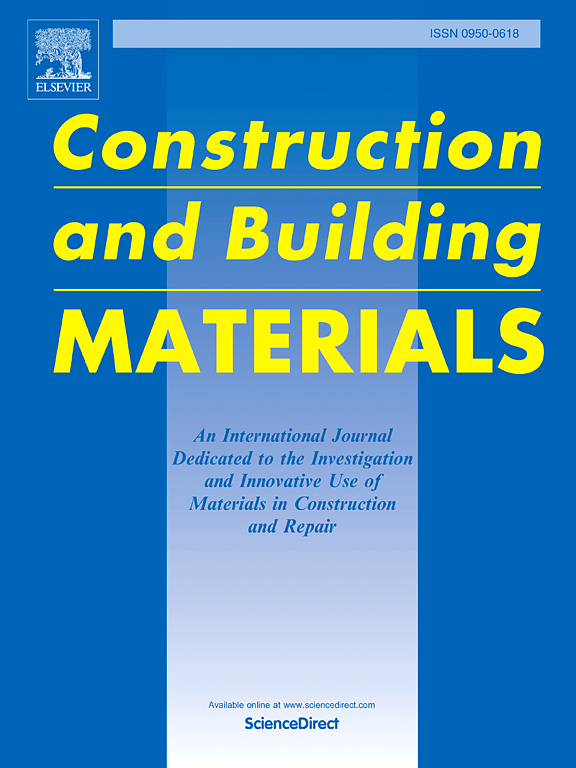Out-of-plane flexural behavior of brick masonry walls reinforced with different fiber-reinforced materials
IF 7.4
1区 工程技术
Q1 CONSTRUCTION & BUILDING TECHNOLOGY
引用次数: 0
Abstract
Masonry walls, as the primary load-bearing elements of masonry structures, are susceptible to out-of-plane loading during earthquakes. To compare the out-of-plane flexural behavior of masonry walls strengthened with different fiber-reinforced materials, 27 masonry beams with a span of 870 mm were subjected to monotonic loading until failure under four-point bending tests. The test variables included material type, highly ductile fiber-reinforced concrete (HDC) thickness, number of carbon fiber reinforced polymer (CFRP) layers and number of textile reinforced mortar (TRM) mesh layers. The failure modes, mid-span load-displacement curve, initial flexural stiffness, ductility coefficient and energy absorption capacity of each group of materials were analyzed and discussed. The results showed that CFRP, HDC and TRM reinforcement could significantly enhance the load-bearing capacity, deformability and ductility of masonry beams. Among them, TRM demonstrated the most pronounced improvement in load-bearing capacity and deformability, attributed to the high tensile strength of carbon fibers and the strain-hardening characteristics of matrix. Additionally, the thickness of the reinforcement layer was observed to significantly influence the out-of-plane flexural behavior of masonry beams. Furthermore, a predictive model for load-bearing capacity was developed. The accuracy and reliability of models were validated through theoretical analyses and experimental results, providing reference for masonry structure reinforcement.
不同纤维增强材料加固砖砌体墙体的面外弯曲性能
砌体墙作为砌体结构的主要承重构件,在地震作用下容易受到面外荷载的影响。为比较不同纤维增强材料加固砌体墙体的面外弯曲性能,对27根跨度为870 mm的砌体梁进行了单调加载至破坏的四点弯曲试验。测试变量包括材料类型、高延性纤维增强混凝土(HDC)厚度、碳纤维增强聚合物(CFRP)层数和纺织增强砂浆(TRM)网层数。对每组材料的破坏模式、跨中荷载-位移曲线、初始抗弯刚度、延性系数和吸能能力进行了分析和讨论。结果表明,CFRP、HDC和TRM配筋能显著提高砌体梁的承载力、变形能力和延性。其中,TRM在承载能力和变形能力方面的改善最为明显,这主要得益于碳纤维的高抗拉强度和基体的应变硬化特性。此外,观察到配筋层的厚度对砌体梁的面外弯曲性能有显著影响。在此基础上,建立了承载能力预测模型。通过理论分析和试验结果验证了模型的准确性和可靠性,为砌体结构加固提供参考。
本文章由计算机程序翻译,如有差异,请以英文原文为准。
求助全文
约1分钟内获得全文
求助全文
来源期刊

Construction and Building Materials
工程技术-材料科学:综合
CiteScore
13.80
自引率
21.60%
发文量
3632
审稿时长
82 days
期刊介绍:
Construction and Building Materials offers an international platform for sharing innovative and original research and development in the realm of construction and building materials, along with their practical applications in new projects and repair practices. The journal publishes a diverse array of pioneering research and application papers, detailing laboratory investigations and, to a limited extent, numerical analyses or reports on full-scale projects. Multi-part papers are discouraged.
Additionally, Construction and Building Materials features comprehensive case studies and insightful review articles that contribute to new insights in the field. Our focus is on papers related to construction materials, excluding those on structural engineering, geotechnics, and unbound highway layers. Covered materials and technologies encompass cement, concrete reinforcement, bricks and mortars, additives, corrosion technology, ceramics, timber, steel, polymers, glass fibers, recycled materials, bamboo, rammed earth, non-conventional building materials, bituminous materials, and applications in railway materials.
 求助内容:
求助内容: 应助结果提醒方式:
应助结果提醒方式:


